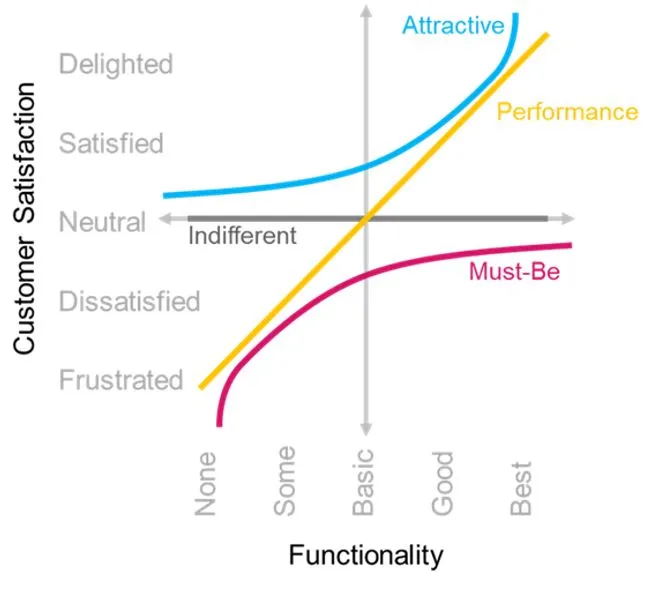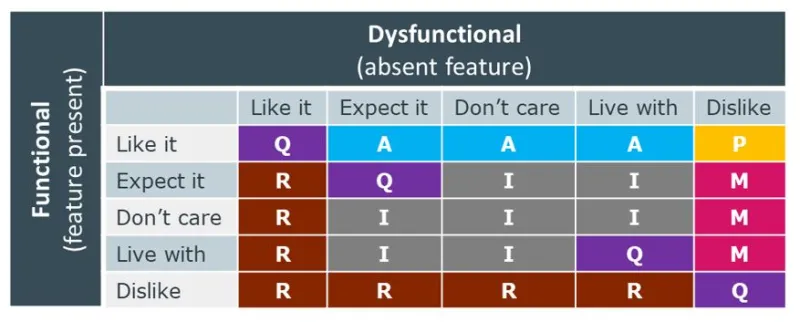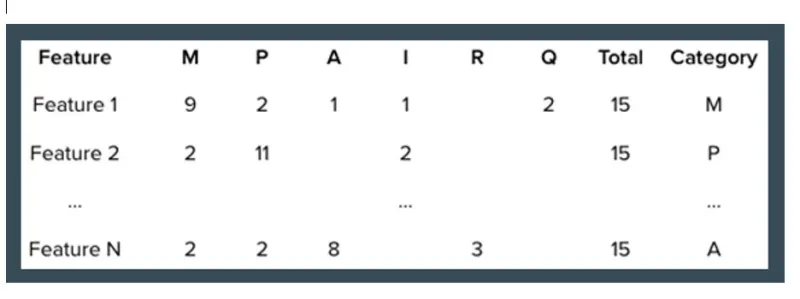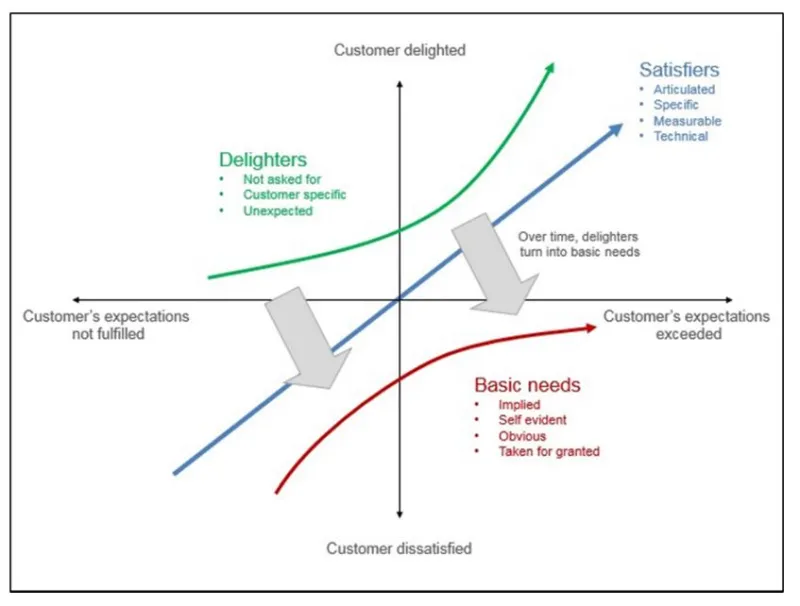Customer satisfaction is fundamental to business success. Satisfied customers are more likely to make repeat purchases and recommend your products and services to others. What is less clear is how to increase customer satisfaction, efficiently and effectively. Enter the Kano Model. The Kano Model is an analysis tool used to identify the features of a product or service that would add to customer satisfaction. We’ll explain how the Model works and why it’s a valuable tool for increasing customer satisfaction.
What is the Kano Model?
The Kano Model is a framework for prioritizing features that will satisfy customers that was developed in the 1980s by Professor Noriaki Kano of Tokyo Rika University. Companies quickly adopted it because it provided a systematic way to rank and prioritize features to successfully increase customer satisfaction. It is also useful for identifying the cause of low customer satisfaction and opportunities for improvement.
How does the Kano Model work?
Kano analysis classifies the features of a service or product into different categories that can be prioritized to maximize customer satisfaction:
1) Delighted: These are the nice surprises for the customer. If the customer gets more than expected, satisfaction will be enhanced. However, as this was not expected, they would not miss it if it wasn’t there.
Example: You have booked an economy flight and you are upgraded to business class.
2) Satisfied: These are elements that are not absolutely necessary but increase customer satisfaction. 'The more the better' or 'The quicker the better.'
Example: You get off the plane, arrive at the conveyor belt and spot your luggage.
3) Neutral: These are elements that rarely affect customers or they’re unlikely to notice.
Example: The shape of the controls on the luggage conveyor belt have minimal impact on product function and will never be seen by the customer.
4) Dissatisfied: These are the 'bare essentials.' If they are not achieved, customer satisfaction will be negatively impacted. However, even if there is a high degree of achievement, customer satisfaction will never be above neutral.
Example: When you fly with luggage, you expect your luggage to arrive at the destination with you. However, if the luggage has not made it, you will be dissatisfied.
5) Frustrated: When customers dislike a feature and prefer not having it.
Example: An airline provides an in-flight menu but the limited options actually lower customer satisfaction.
Grouping service or product features according to these categories will make it clearer which features to focus on improving for maximum impact. An airline, for instance, might use these insights to prioritize fixing pain points in its luggage handling system instead of upgrading more customers.

How do I use the Kano Model in the CX world?
Step 1: Have customers fill out the Kano Questionnaire
The Kano Questionnaire allows a company to identify its customers’ perception of features in order to evaluate them. It includes questions such as:
How do you feel if you have this feature? – Functional/Positive
How do you feel if you do NOT have this feature? –Dysfunctional/Negative
Pro tips:
Choose tangible features to study with some meaningful benefit to customers and don’t go overboard with the number of features in your study. This will improve participation rates and the quality of responses.
Choose your participants wisely to reduce noise in your results. Choose a sample size that is representative of your customer segmentation – customers grouped by demographics or behaviors – your market segmentation, and your target marketing strategy. Approximately 15-20 is a good sample size.
Write clear questions that are phrased in terms of benefit to the participant.

Present your answer set along a scale:
- I like it
- I expect it
- I am neutral
- I can tolerate it
- I dislike it
Step 2: Evaluate and categorize the questionnaire results
Once you have collected voice of the customer statements, list all the 'critical to quality' (CTQ) characteristics of the service or product onto the Kano analysis worksheet. Classify each CTQ as a dissatisfier, satisfier, or delighter and then review with the team and set priorities for improvement.

Tracking customer satisfaction
There are many ways to track customer satisfaction. The Net Promoter Score (NPS), for instance is a common tool for measuring customer satisfaction to learn how customers feel about your business and how your business compares to others. However, NPS is just the tip of the iceberg. To really effect change, a business must dive deeper to find the cause of lowered customer satisfaction and the factors that affect it. The Kano analysis is a great way to do that and take customer satisfaction to a whole new level, one that has the potential to make your business an industry leader.
The Kano Model in action
Knowledge management, performance management, accurate timekeeping, coaching, training, professional development and communication are all essential to employee satisfaction. Now, imagine all of these elements not only available but accessible in one central location, a hub for contact center employees to get where they need to be and find the information they need immediately.
Using the Kano Model to understand the impact of each element on employee satisfaction, TTEC is building an insight-driven internal tool for employees that does exactly that with several Delighters mixed in. The objective is a happier, healthier, more engaged employee population who will provide best-in-class service to our clients and our clients’ customers.
Key takeaways

- If you have collected voice of the customer statements, you can list all the 'critical to quality' (CTQ) characteristics of the service or product onto the Kano analysis worksheet.
- You can classify each CTQ as a dissatisfier, satisfier or delighter and then review with the team and set priorities for improvement.
- Delighters can be used when something has gone wrong to outperform the problem (e.g. providing an upgrade in a hotel or a complimentary dessert in a restaurant).
- It is worth bearing in mind that today's delighters become tomorrow's expectations; therefore, service and product features should be kept under constant review. Just think about how our expectations of mobile phones have changed over the years…
- Different groups of customers may have different expectations, so it might be necessary to carry out a separate Kano analysis for each group to get complete insight into customer satisfaction.
- Good improvement projects will look into improving not only the dissatisfiers but also the satisfiers.
Satisfied customers are a boon for any business, but it’s not always apparent what drives customer satisfaction. The Kano Model is a valuable addition to a company’s customer experience toolkit, enabling companies to systematically identify the factors that affect customer satisfaction and deploy them efficiently and effectively for maximum results.


